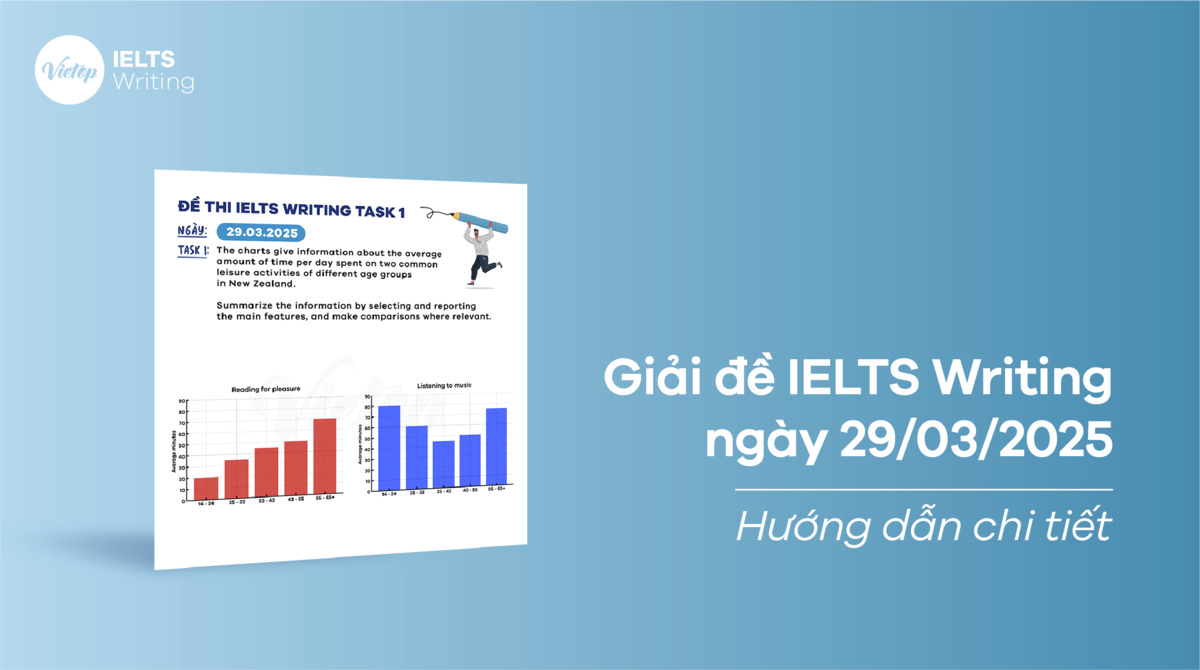Trong kỳ thi IELTS ngày 15/03/2025, đề thi IELTS Writing đã ra dạng đề Advantages and Disadvantages ở Writing Task 2. Theo cảm nhận cá nhân của mình, đề Task 2 này có mức độ phức tạp trung bình, với chủ đề rất thực tế.
Cụ thể, đề bài như sau:
- Đề IELTS Writing Task 2: Many young people are leaving their homes in rural areas to study or work in the cities. Do the advantages of this development outweigh its disadvantages?
Trong bài viết này, mình sẽ chia sẻ với bạn cách tiếp cận dạng bài này một cách hiệu quả – bắt đầu từ việc phân tích đề, xây dựng dàn ý rõ ràng cho đến áp dụng các chiến lược viết giúp bài làm mạch lạc, logic và thuyết phục hơn. Từ đó, bạn sẽ cảm thấy tự tin hơn và có cơ hội nâng cao band điểm đúng như kỳ vọng!
Cùng mình học bài thôi!
1. IELTS Writing Task 2
| Many young people are leaving their homes in rural areas to study or work in the cities. Do the advantages of this development outweigh its disadvantages? |
| (Nhiều người trẻ đang rời khỏi quê hương ở vùng nông thôn để lên thành phố học tập hoặc làm việc. Liệu những lợi ích của xu hướng này có vượt trội hơn so với những tác hại mà nó mang lại hay không?) |
1.1. Bước 1: Phân tích đề
- Dạng bài: Advantages – Disadvantages (có outweigh)
- Từ khóa: Many young people, leaving their homes, rural areas, to study or work, cities, advantages, outweigh its disadvantages
- Phân tích yêu cầu:
- Đề bài đưa ra bối cảnh: Nhiều người trẻ hiện nay rời khỏi quê hương mình ở các vùng nông thôn để tới thành phố lớn học tập và tìm việc làm
- Yêu cầu đề bài: Đưa ra lợi ích, bất lợi của hiện tượng này, và nêu quan điểm của bạn rằng lợi ích có vượt trội hơn bất lợi hay không
=> Mình sẽ viết theo hướng Disadvantages > Advantages, với quan điểm rằng: Hiện tượng này có thể có lợi ích ngắn hạn, nhưng bất lợi cho quốc gia và xã hội là dài hạn, với sự bất bình đẳng giữa thành thị và nông thôn ngày càng lớn, vì thành thị thì bị quá tải dân số, còn nông thôn thì có dân số quá ít, gây áp lực cho cả thành thị và nông thôn
=> Bài viết có từ 2-3 đoạn thân bài.
1.2. Bước 2: Lập dàn ý
| Introduction: Viết lại đề bài theo cách khác, sau đó đưa ra quan điểm cá nhân. | |
| Body paragraph 1: – Point: Urban migration makes sense on an individual level. – Explain: Cities offer better education, job diversity, and lifestyle options. – Example: A young person from a village sees the city as the only path to success. – Link: These benefits are real-but they don’t tell the full story. | |
| Body paragraph 2: – Point: Mass migration causes rural areas to lose their core population. – Explain: Fewer young people = shrinking local economies, services, and long-term vitality. – Example: Villages become elderly-heavy and dependent on government assistance. – Link: These areas cannot thrive if no one stays behind to build them. | |
| Body paragraph 3: – Point: The effects aren’t limited to rural areas-cities suffer too. – Explain: Overcrowding, housing crises, and overstretched infrastructure arise.This creates growing inequality and long-term imbalance between rural and urban areas. – Link: A seemingly personal choice becomes a national structural issue. | |
| Conclusion: Viết lại mở bài theo cách khác, nhắc lại quan điểm cá nhân. Tóm tắt các main idea đã viết trong các đoạn thân bài. |
Xem thêm:
- Cách viết mở bài Writing Task 2
- Cách viết Conclusion trong IELTS Writing task 2
- Tổng hợp các cấu trúc câu IELTS Writing Task 2
1.3. Bước 3: Bài mẫu
1.3.1. Bài mẫu band 5.0+
Now many young people moving to cities from rural places because they want better jobs and school. Some people think it is good for the people but I think it have many bad things in long time and it is not good for the countryside.
First, it is true that cities have more chances for young people. There are more job and better education for people who want to success. In the village there is not many thing to do and most people do farming. So they want to move to the big city and make better life. They can get more money and help their family.
But this also make many problem. When all the young people go to the city, the village become more empty. There is only old people stay and nobody to help them or work in the farms. The shops also close because no customer. Then the village go down and cannot grow again.
Also city become too full with so many people. There is not enough house and the rent is high. Traffic is big and school and hospital is too busy. When too many people live in one place, it is not good for life. It also make more poor people in the city who cannot find good job.
In conclusion, even if some people get better chance in the city, I think this is not good for the country. The countryside lose all the young people and the city become too much crowded. So the bad side is more than the good one.
1.3.2. Bài mẫu band 7.5+
In recent years, the migration of young people from rural areas to cities has become a widespread trend. While this shift is often seen as a natural step towards opportunities and growth, I believe the long-term consequences for rural communities and national balance are too serious to overlook. Unless a sustainable solution is found – and not just temporary government intervention – the disadvantages of this development are likely to outweigh its benefits.
It is understandable why so many young individuals choose to leave their hometowns. Cities offer better universities, diverse job markets, and a chance for financial and personal independence. For someone from a small farming village, the city may represent a future that simply does not exist back home. In many cases, people who move gain access to a better quality of life and may even send money back to support their families. On an individual level, the advantages are clear.
However, the issue arises when this trend becomes widespread and irreversible. As more young people leave, rural communities begin to hollow out–losing not only their workforce, but also their future. Local economies shrink, essential services disappear, and the remaining population grows older and more dependent. What was once a self-sustaining community becomes reliant on outside support to thrive. Government programs may attempt to address this, but real solutions are hard to implement without people actually staying, building, and investing in those places.
Moreover, the imbalance this creates is not limited to the countryside. Cities quickly become overcrowded, housing becomes unaffordable, and infrastructure struggles to keep up. What starts as a personal choice for a better life ends up contributing to national inequality—between urban and rural, young and old, connected and forgotten. This is not a short-term inconvenience, it is a long-term restructuring of society with consequences we are only beginning to understand.
In conclusion, while moving to urban areas may offer personal and economic benefits, the larger social and demographic impact is troubling. Without real, grassroots solutions that make rural life viable again, this trend will continue to chip away at rural communities and concentrate opportunity in only a few places. For that reason, I believe the disadvantages of this development outweigh the advantages.
1.4. Từ vựng
| Từ vựng | Nghĩa |
| Migration /maɪˈɡreɪʃən/ | (noun) di cư E.g. Urban migration has increased rapidly in recent years. (Việc di cư lên thành phố dạo gần đây tăng khá nhanh.) |
| National balance /ˈnæʃnəl ˈbæləns/ | (noun phrase (collocation)) sự cân bằng quốc gia E.g. Uneven development can affect the national balance. (Phát triển không đồng đều có thể làm ảnh hưởng tới sự cân bằng của cả nước.) |
| Overlook /ˌoʊvɚˈlʊk/ | (verb) bỏ sót, không để ý E.g. Many policies overlook rural communities. (Nhiều chính sách bỏ sót mấy vùng quê.) |
| Government intervention /ˈɡʌvərnmənt ˌɪntərˈvɛnʃən/ | (noun phrase) sự can thiệp của chính phủ E.g. Government intervention is needed to control housing prices. (Cần có sự can thiệp của Nhà nước mới kiểm soát nổi giá nhà.) |
| Quality of life /ˈkwɑːləti əv laɪf/ | (noun phrase) chất lượng cuộc sống E.g. Clean air greatly improves the quality of life. (Không khí trong lành giúp nâng cao chất lượng sống rõ rệt.) |
| Widespread /ˈwaɪdspred/ | (adjective) lan rộng, phổ biến E.g. There is widespread support for climate action. (Có sự ủng hộ rộng khắp cho việc chống biến đổi khí hậu.) |
| Irreversible /ˌɪrɪˈvɜːrsəbl/ | (adjective) không thể đảo ngược E.g. Climate change could cause irreversible damage. (Biến đổi khí hậu có thể gây ra hậu quả không thể cứu vãn được.) |
| Essential services /ɪˈsɛnʃəl ˈsɜːrvɪsɪz/ | (noun phrase) dịch vụ thiết yếu E.g. Rural areas often lack essential services. (Ở quê thường thiếu dịch vụ thiết yếu.) |
| Self-sustaining community /ˌsɛlf səˈsteɪnɪŋ kəˈmjuːnəti/ | (noun phrase) cộng đồng tự chủ E.g. A self-sustaining community produces its own food and energy. (Cộng đồng tự chủ thì tự trồng đồ ăn, tự tạo năng lượng.) |
| Reliant /rɪˈlaɪənt/ | (adjective) phụ thuộc E.g. Some areas are too reliant on imported goods. (Nhiều nơi phụ thuộc quá mức vô hàng nhập.) |
| Imbalance /ɪmˈbæləns/ | (noun) sự mất cân bằng E.g. Economic imbalance leads to social issues. (Mất cân bằng kinh tế kéo theo nhiều vấn đề xã hội.) |
| Overcrowded /ˌoʊvɚˈkraʊdɪd/ | (adjective) quá đông, chật chội E.g. The city center is becoming overcrowded. (Trung tâm thành phố giờ đông nghẹt người.) |
| Unaffordable /ˌʌnəˈfɔːrdəbl/ | (adjective) không thể chi trả nổi E.g. Housing in major cities is becoming unaffordable. (Nhà ở mấy thành phố lớn giờ quá mắc tiền, mua không nổi.) |
| Infrastructure /ˈɪnfrəstrʌktʃɚ/ | (noun) cơ sở hạ tầng E.g. Poor infrastructure can slow down development. (Hạ tầng yếu kém thì phát triển cũng chậm theo.) |
| Short-term inconvenience /ʃɔːrt tɜːrm ˌɪnkənˈviːniəns/ | (noun phrase) sự bất tiện tạm thời E.g. Construction causes short-term inconvenience but long-term benefits. (Làm công trình thì gây bất tiện tạm thời, nhưng lợi ích thì lâu dài.) |
| Demographic /ˌdɛməˈɡræfɪk/ | (noun/adjective) dân số học/ nhóm dân cư E.g. The aging demographic poses economic challenges. (Dân số già đi là một bài toán kinh tế lớn.) |
| Grassroots solutions /ˌɡræsˈruːts səˈluːʃənz/ | (noun phrase (collocation)) giải pháp từ cơ sở/ gốc rễ/ dân chúng E.g. Grassroots solutions often have stronger community support. (Mấy giải pháp từ dân chúng thường được ủng hộ hơn.) |
| Viable /ˈvaɪəbl/ | (adjective) khả thi E.g. Public transport is a viable solution to traffic congestion. (Giao thông công cộng là giải pháp khả thi để giảm kẹt xe.) |
| Chip away /tʃɪp əˈweɪ/ | (phrasal verb) bào mòn dần dần, từng chút một E.g. Rising prices are slowly chipping away at people’s savings. (Giá cả leo thang bào mòn từng chút một tiền tiết kiệm của dân.) |
| Hollow out /ˈhɑːloʊ aʊt/ | (phrasal verb) làm rỗng ruột, làm mất đi giá trị hoặc sức mạnh bên trong E.g. Global outsourcing has hollowed out many local industries. (Việc thuê ngoài toàn cầu đã làm rỗng ruột nhiều ngành công nghiệp địa phương.) |
Xem thêm các bài giải đề:
- [ACE THE TEST] Giải đề IELTS Writing ngày 22/03/2025
- [ACE THE TEST] Giải đề IELTS Writing ngày 08/03/2025
- [ACE THE TEST] Giải đề IELTS Writing ngày 06/03/2025
- Tổng hợp đề thi IELTS Writing 2025 kèm bài mẫu chi tiết
2. Kết luận
Việc chinh phục IELTS Writing không phải là chuyện “một sớm một chiều”, nhưng với chiến lược đúng đắn và sự luyện tập đều đặn, bạn hoàn toàn có thể biến phần thi này thành lợi thế của mình.
Với những chia sẻ từ bài giải đề IELTS Writing ngày 15/03/2025, bạn sẽ có thêm nhiều tips làm bài hay trong việc phân tích đề, lập dàn ý và cách triển khai ý tưởng đối với dạng bài Advantages – Disadvantages (có outweigh).
Nếu bạn còn thắc mắc hay muốn được hỗ trợ thêm, đừng ngần ngại để lại bình luận bên dưới. Vietop English sẽ giúp bạn giải đáp chi tiết để luyện tập hiệu quả khi ôn luyện kỹ năng Writing.
Chúc bạn ôn luyện thật hiệu quả và bứt phá band điểm như kỳ vọng!


![[ACE THE TEST] Giải đề IELTS Writing ngày 07/04/2025](https://vietop.edu.vn/wp-content/uploads/2025/04/giai-de-ielts-writing-ngay-07-04-2025.png)

![[ACE THE TEST] Giải đề IELTS Writing ngày 22/03/2025](https://vietop.edu.vn/wp-content/uploads/2025/03/giai-de-ielts-writing-ngay-22-03-2025.jpg)
![[ACE THE TEST] Giải đề IELTS Writing ngày 08/03/2025](https://vietop.edu.vn/wp-content/uploads/2025/03/giai-de-ielts-writing-ngay-08-03-2025.jpg)
![[ACE THE TEST] Giải đề IELTS Writing ngày 06/03/2025](https://vietop.edu.vn/wp-content/uploads/2025/03/giai-de-ielts-writing-ngay-06-03-2025.jpg)
![[ACE THE TEST] Giải đề IELTS Writing ngày 22/02/2025](https://vietop.edu.vn/wp-content/uploads/2025/02/giai-de-ielts-writing-ngay-22-02-2025.jpg)
![[ACE THE TEST] Giải đề IELTS Writing ngày 13/02/2025](https://vietop.edu.vn/wp-content/uploads/2025/02/giai-de-ielts-writing-ngay-13-02-2025.jpg)
